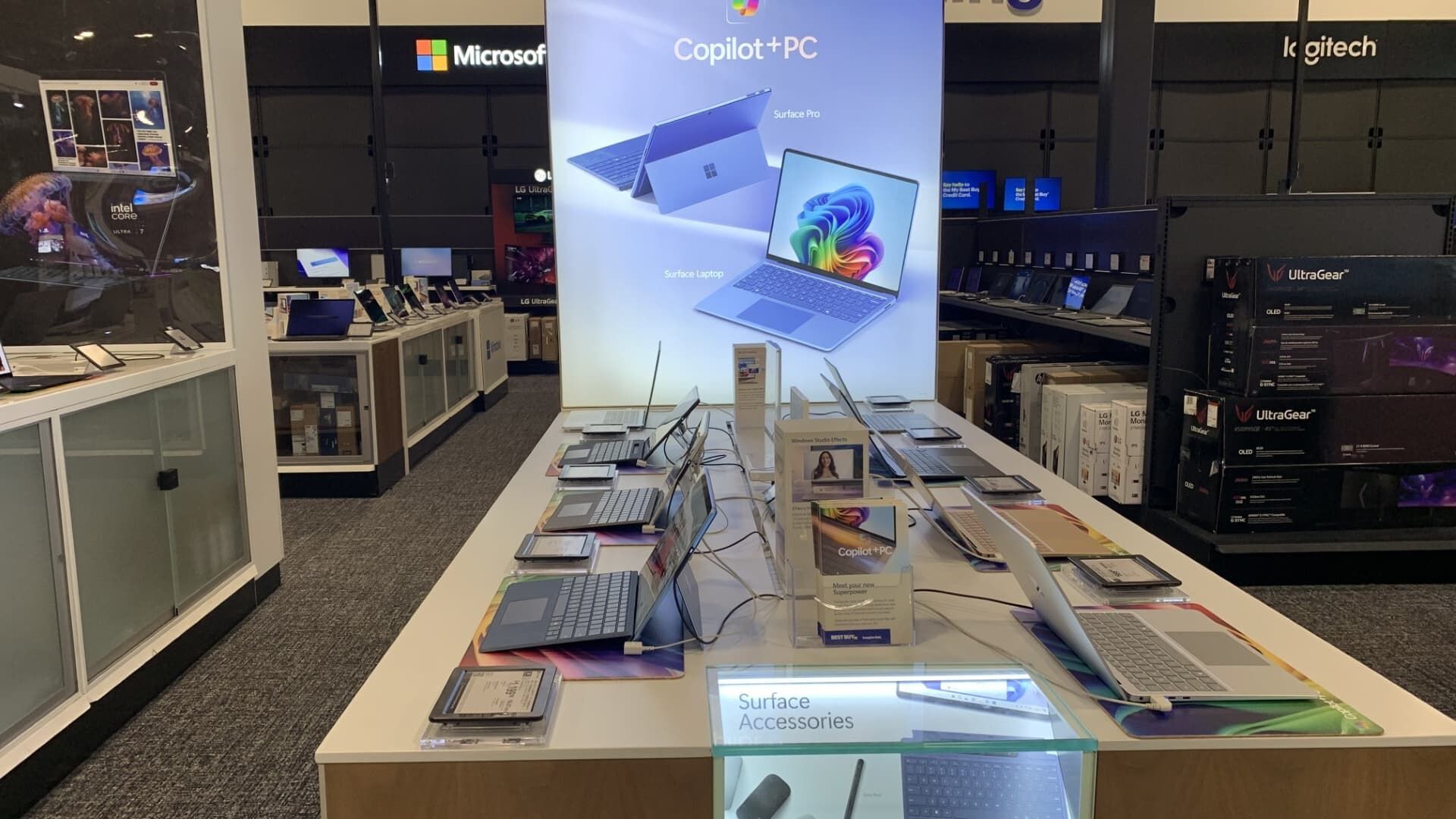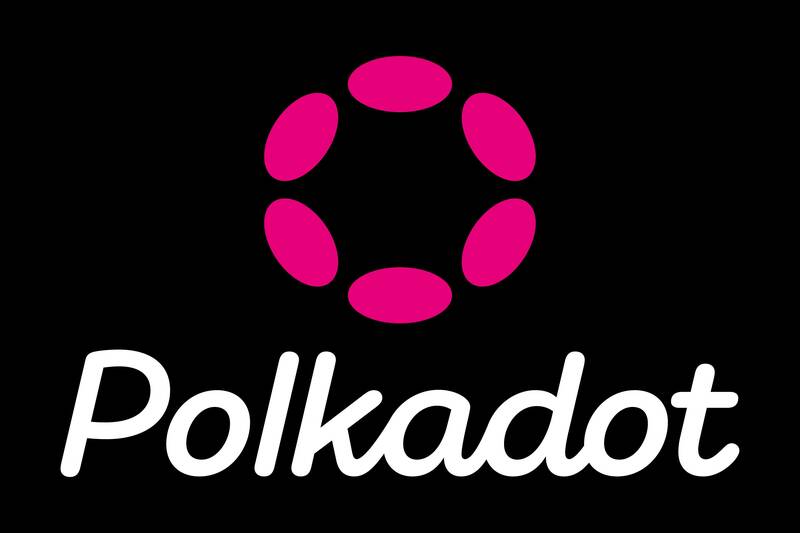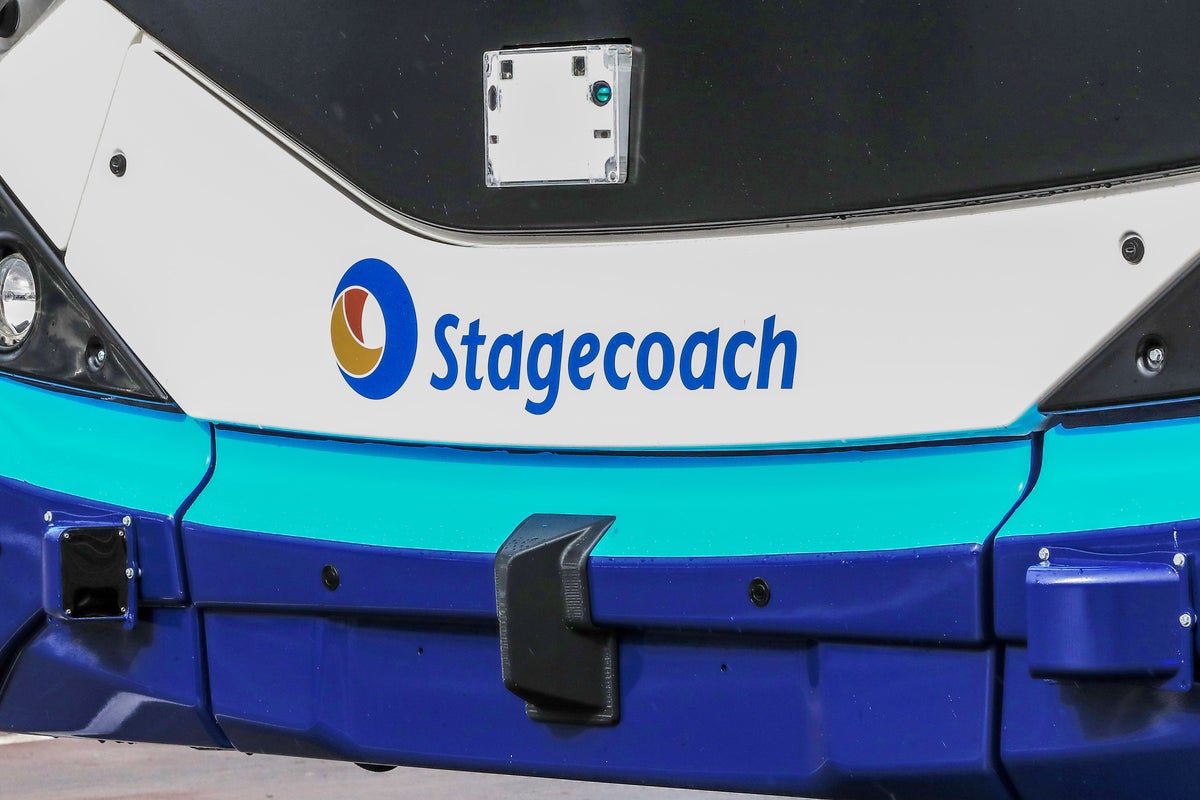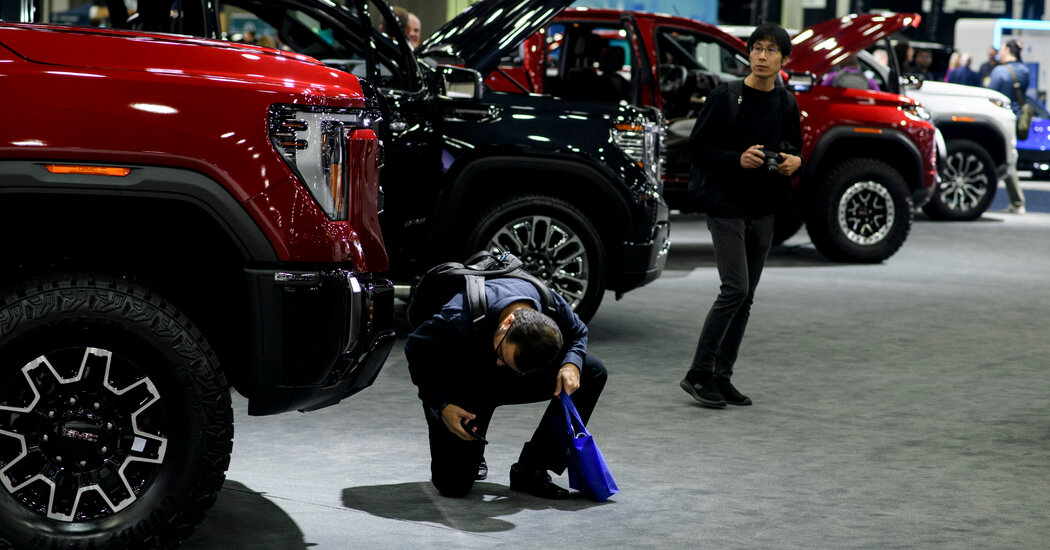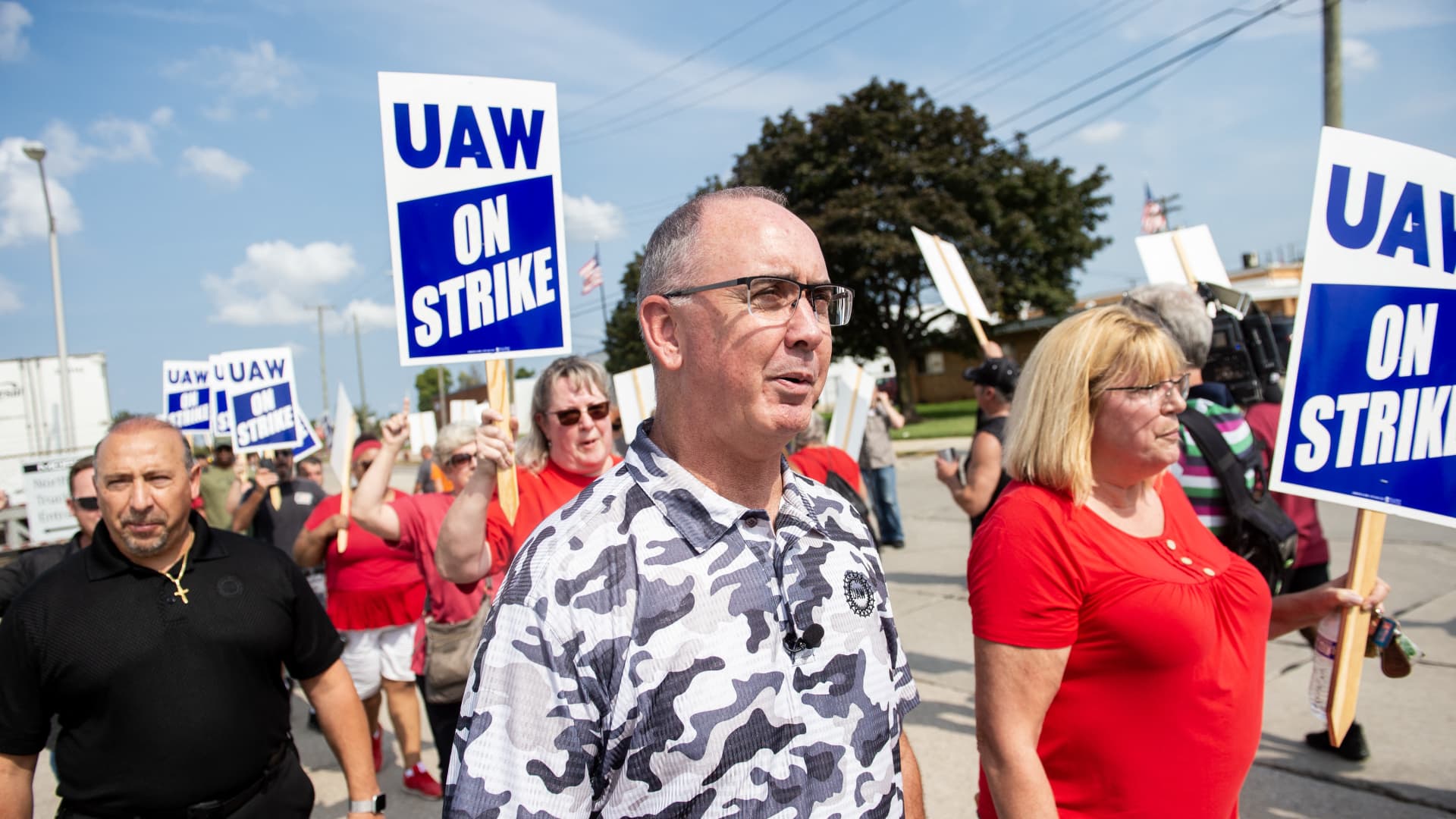Microsoft PCs on display at a Best Buy store in Secaucus, New Jersey
Melissa Repko | CNBC
Best Buy On Tuesday, it announced new plans to try to reverse a two-year sales slump and capitalize on a long-awaited pandemic-era replacement cycle of purchases and a new wave of innovation.
The consumer electronics retailer said it would add trained sales teams to key parts of its stores, create more YouTube videos to pique customer curiosity and launch a marketing campaign with a new tagline: “Imagine That.”
In an interview with CNBC, CEO Corie Barry said customers told Best Buy that the retailers' store experiences and the technology they offer have “lost a little bit of their appeal.” [their] “Brilliant,” he added, adding that innovation in consumer electronics has hit a dry spell.
“That's our main goal this year,” he said. “To bring back everything 'new'.”
One of Best Buy's main hopes for boosting sales comes from artificial intelligence-enabled laptops and smartphones.
The retailer doesn’t expect its sales to improve overnight, however. The company has reported 10 consecutive quarters of declining comparable sales, a key metric that strips out the impact of store openings and closings. Best Buy said in May that it expects full-year comparable sales to be virtually unchanged or fall as much as 3% compared with a year ago.
Best Buy expects revenue to be between $41.3 billion and $42.6 billion, down from $46.3 billion last year. That would put its revenue slightly below the $43.6 billion it posted in the pre-pandemic fiscal year that ended in early 2020.
Barry said consumers are still “making very clear, value-based decisions.”
Best Buy's stock has reflected the sales woes: As of Monday's close, shares are down about 36% from their all-time high of $138, which the stock hit during the Covid pandemic.
Steven Zaccone, an equity research analyst who covers retail for Citi Research, upgraded his rating on Best Buy stock from sell to buy in early June, in part because of an expected wave of new products.
But he acknowledged that trends have become harder to predict as consumers guard their wallets after the highest inflation in decades and are distracted by the uncertainty of this year's presidential election.
“Those who focus on the short term would say that the category is still in decline,” he said. “So the prediction is based on the hope that there will be a turn toward growth.”
Wearable technology on display at a Best Buy store in Secaucus, New Jersey
Melissa Repko | CNBC
Encouraging a replacement cycle
Best Buy executives and investors have reason to be optimistic. In each of the past two quarters, Best Buy's laptop sales were higher than in the prior-year periods, early signs that a replacement and upgrade cycle could be beginning.
Last week, purchases of consumer electronics such as tablets, TVs and Bluetooth speakers helped drive sales to a record $14.2 billion on U.S. retailers’ websites during Amazon’s two-day Prime event, according to Adobe Analytics. It was a turnaround from last year, when shoppers, exhausted by inflation, took advantage of deals on household staples. (Best Buy is among retailers that have participated in the Amazon-created retail holiday by offering its own deals.)
Best Buy's ability to boost sales depends in part on its suppliers. The company has sought innovations that give customers new reasons to come to its stores or website.
In recent months, Apple, Samsung and Microsoft They've announced new releases that could generate buzz and boost customer traffic. Apple launched a collection of new iPads in May. Earlier this month, Samsung introduced its first “smart rings” with health-tracking features to compete with Apple's own Oura Ring and Watch.
Separately, Microsoft announced in May a collection of new PCs that include Copilot, an AI-powered chatbot. The collection, which includes about 40 different items, about 40 percent of which are exclusive to Best Buy, began shipping in mid-June.
Barry said the retail chain will benefit as customers see those advances in technology and stores offer entirely new lines of business, such as rings that It can track sleep, physical activity and more.
“Five years ago, we would never have had jewelry in our stores and now we're going to have a whole section of wellness-oriented products that you can use in really unique ways,” she said.
Best Buy is launching a new marketing campaign for this back-to-school season, featuring a “spokesperson hologram” named Gram and a new tagline, “Imagine That.”
Courtesy: Best Buy
Less technical specifications, more discovery
Instead of listing the dimensions of TVs and laptops, Best Buy staff will focus on helping customers understand how items can save them time or make their lives easier, Barry said.
In stores, customers will see more experiential displays showcasing products like Tesla chargers, GoPro video equipment and Lovesac furniture later this summer. It will also add dedicated equipment to its computing, appliances and home theater sections — three key areas where Barry said customers tend to need support.
Barry said employees at those stores will highlight unique features that customers may not know about, such as a laptop with more than double the battery life, a washer-dryer combo that lets them wash two loads of laundry at once or a home theater system that can make a workout space feel like a spin studio.
In the Best Buy app, customers will see a personalized home screen, a new “Discover” tab and the ability to set alerts for when an item on their wish list goes on sale.
The company plans to release more than 500 videos by the end of the year on its YouTube channel, app and website. That's triple the number it added last year.
And as it gears up for back-to-school season, Best Buy will be launching ads online, on streaming services and on social media that will feature a “spokesperson hologram” named Gram.
“We're doubling down on what makes us different and I believe we're uniquely able to help make the 'What if?' question a reality for our customers,” Barry said.
Best Buy, however, will be implementing this more targeted strategy for the customer on a tighter budget. Barry said on the company’s earnings call in May that the retailer plans to spend about $750 million on capital this fiscal year, about $50 million less than last year. It is reducing spending with “renovations” of all of its roughly 900 U.S. stores rather than major remodels and new store openings, he said.
The company's dedicated teams at part of the store will be made up of its existing workforce and supplemented by employees from its suppliers, it told CNBC.
A Best Buy store in Woodbridge, Virginia, U.S., on Tuesday, May 21, 2024.
Nathan Howard | Bloomberg | Getty Images
'Murphy's Law of Headwinds'
Best Buy has faced a “Murphy's Law of headwinds” over the past three years, said Scot Ciccarelli, an equity research analyst at Truist Securities, referring to the adage that “anything that can go wrong, will go wrong.”
Among the challenges facing the company: Consumers have held off on bigger-ticket purchases like smartphones because of rising everyday costs like groceries, gas and rent. Lower employee turnover in the housing market, driven by higher interest rates, has dampened demand for home-related purchases like a bigger TV or new kitchen appliances.
But Ciccarelli said Best Buy’s unusually high sales during the pandemic have been what has hurt the retailer the most. It threw off the typical cadence of shoppers replacing smartphones, laptops, appliances and more, as many of them bought that technology as they set up their home offices, gyms and kitchens during the Covid shutdown.
Additionally, as consumer electronics brands have had to deal with temporarily shuttered factories and clogged supply chains during the pandemic, they have introduced less innovative technologies. Without those advancements, Best Buy has been forced to compete on price, as it sells roughly the same devices as competitors like Amazon and Walmart — particularly if customers have little reason to touch or feel a product before buying it, Ciccarelli said.
Consumer electronics has been a weaker category at retail, with sales down 4% in dollars and 5% in units through the end of June compared with the same period a year earlier, according to Circana, a market research firm that tracks point-of-sale data at major U.S. retailers. The market research firm’s definition includes most major devices, such as TVs, tablets and audio equipment, but excludes some categories that Best Buy sells, such as appliances.
However, spending on consumer electronics rose 5% this year compared with the same pre-pandemic period in 2019, according to Circana.
Part of the increase is due to higher prices for computers, TVs and other items, said Paul Gagnon, a consumer technology industry adviser at Circana. For example, he said the average price spent on items in the headphones category rose 60% compared with 2019 as customers gravitated toward wireless earbuds like Apple’s Airpods or wireless over-ear headphones.
The peak season for consumer electronics sales is still ahead. According to data from Circana, historically around 57% of sales in the category have occurred in the second half of the year.
And the biggest days for consumer electronics are still ahead: back-to-school season and the holidays.

